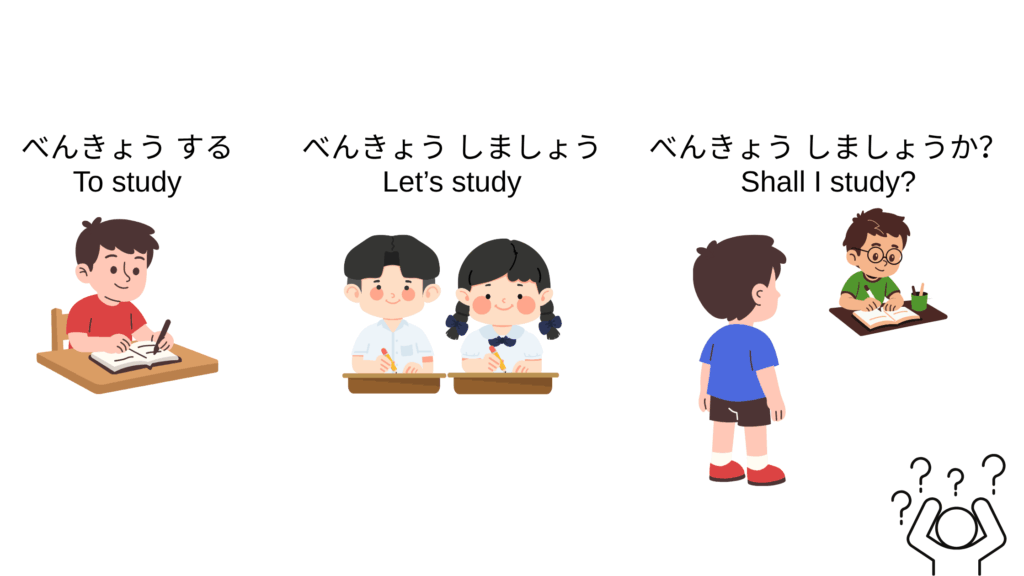Hey there, fellow language adventurers! If you’re an adult juggling work, life, and the exciting journey of learning Japanese, welcome back to our 100-day challenge aimed at conquering JLPT N5.
We’re already on Day 43 – that’s over 40% through! Let’s get started!
Main Lesson: Breaking Down ましょう and ましょうか Step by Step
First, a quick refresher: In Japanese, verbs often end in the polite “ます” form (like たべます for “eat”). To make suggestions or offers, we tweak that ending. Let’s break it down.
Grammar Rules
ましょう (mashou) – “Let’s ~” or “Shall we ~?”
This is the volitional form, used for polite suggestions to do something together.
How to form it:
Take a verb in ます form, drop “ます,” and add “ましょう.”
Example:
たべます (Tabemasu) → たべましょう (Tabemashou)
Use it when including yourself and the listener(s) in the action. It’s great for group activities or invitations.
It’s polite, so perfect for friends, colleagues, or casual polite settings.
ましょうか (mashou ka) – “Shall I ~?” (Offering help)
This adds “ka” (question particle) to mashou, turning it into an offer of assistance.
How to form it:
Same as above, but add “ka” at the end.
Example:
たべます (Tabemasu) → たべましょうか? (Tabemashou ka?)
Use this when you’re offering to do something for the listener.
It shows kindness and politeness, like in service situations or helping friends.
Key nuance:
It’s not asking if “we” should do it; it’s “Should I do this for you?”
Remember, these work with most verbs, but irregular ones like する(do) become しましょう. We’ll stick to regulars for now.
Learn When “~mashou” and “~mashou ka?” Sound Unnatural
We have explained that you can create sentences by simply changing the end of a verb to “~ましょう” or “~ましょうか?”, but this does not work with every verb.
“~ましょう” is an expression that shows “Let’s do it together!” The speaker is motivated and indicates that they will act together with the listener.
On the other hand, “~ましょうか?” is a polite way to ask “Do you want to do it together?”
The key point is whether the speaker is willing to do it and whether they are asking the other person.
Why “くる” Sounds Unnatural as “きましょう / きましょうか?”
The verb “いく” (to go) describes the speaker’s own movement, while “くる” (to come) usually refers to the other person’s movement.

For example, 「いえ に いく」 (to go home) means the speaker is walking toward their house, whereas 「いえ に くる」 (to come home) means someone else is walking toward where the speaker is.

When you say 「いきましょう」 (let’s go), it assumes that the speaker and the listener will move together toward the same destination.

However, saying 「きましょう」 (let’s come) feels strange, because if the speaker and listener are already in the same place, 「いきましょう」 fits better.
If they are in different places, then 「〜ましょう」, which carries the nuance of doing something together, creates a contradiction — since 「くる」 describes movement toward the speaker, not with the speaker.
For the same reason, 「きましょうか?」 (shall we come?) also sounds unnatural.
If the speaker and listener are in the same place, it’s better to say 「(いっしょに)いきましょうか?」 (shall we go together?).
If they are in different places and the speaker wants to confirm whether the listener will come, expressions like 「きますか?」 (will you come?), 「きませんか?」 (won’t you come?), or 「きたいですか?」 (do you want to come?) sound more natural.
The Difference Between “べんきょう しましょう” and “べんきょう しましょうか?”

The phrase 「べんきょう しましょう」 means “Let’s study together!” and is a natural, friendly invitation.
On the other hand, 「べんきょう しましょうか?」 does not really sound like an invitation.
Instead, it carries the nuance of “If you want me to, I will study.”
It focuses more on the speaker’s willingness rather than suggesting joint action.
If your goal is to invite someone to study, 「べんきょう しませんか?」 (won’t you study?) is the more natural and polite choice.
Vocabulary List
To make examples pop, here’s a handy list of common N5-level verbs in ます form. Practice conjugating them!
| Words | Meaning | ます | ましょう | ましょうか |
|---|---|---|---|---|
| のむ (nomu) | drink | のみます | のみましょう | のみましょうか |
| いく (iku) | go | いきます | いきましょう | いきましょうか |
| よむ (yomu) | read | よみます | よみましょう | よみましょうか |
| かく (kaku) | write | かきます | かきましょう | かきましょうか |
| はなす (hanasu) | speak/talk | はなします | はなしましょう | はなしましょうか |
| つくる (tsukuru) | make | つくります | つくりましょう | つくりましょうか |
Use these to build sentences. Pro tip: Pair with particles like o (object), ni (to), de (at), etc., from earlier days.
Examples
Let’s see these in action! Practice saying them aloud.
おちゃ を のみましょう。 (Ocha wo nomimashou.)
– Let’s drink some tea.
こうえん に いきましょう。 (Kouen ni ikimashou.)
– Let’s go to the park.
にもつ を もちましょう か? (Nimotsu wo mochimashou ka.)
– Shall I carry your luggage?
にほんご を おしえましょう か? (Nihongo wo oshiemasyou ka.)
– Shall I teach you Japanese?
いっしょ に ほん を よみましょう。 (Issho ni hon wo yomimashou.)
– Let’s read a book together.
ちず を かきましょう か? (Chizu wo kakimashou ka.)
– Shall I draw a map?
せんせい と はなしましょう。 (Sensei to hanashimashou.)
– Let’s talk with the teacher.
もんだい を つくりましょう か? (Mondai wo tsukurimashou ka.)
– Shall I create a quiz?
Conclusion: Wrapping Up and Looking Ahead
Whew, Day 43 done! Key takeaways: ましょう turns verbs into polite “let’s” suggestions for shared actions, while ましょうか offers help like “shall I do this for you?” You now have rules, vocab, examples.
Stay consistent, folks – even 15 minutes a day adds up. You’re building a skill for travel, career, or pure joy. If this helped your journey to learn Japanese for beginners, hit that subscribe button for daily emails, or share this post with a friend tackling JLPT N5.



